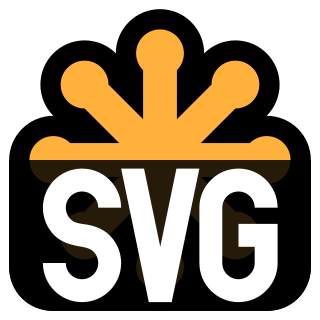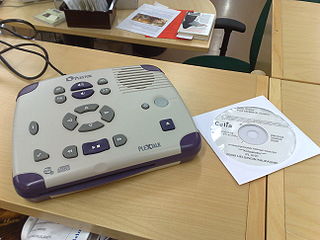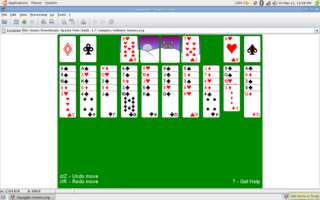Related Research Articles

Scalable Vector Graphics (SVG) is an XML-based vector image format for two-dimensional graphics with support for interactivity and animation. The SVG specification is an open standard developed by the World Wide Web Consortium (W3C) since 1999.

Synchronized Multimedia Integration Language ) is a World Wide Web Consortium recommended Extensible Markup Language (XML) markup language to describe multimedia presentations. It defines markup for timing, layout, animations, visual transitions, and media embedding, among other things. SMIL allows presenting media items such as text, images, video, audio, links to other SMIL presentations, and files from multiple web servers. SMIL markup is written in XML, and has similarities to HTML.
MPEG-4 Part 11Scene description and application engine was published as ISO/IEC 14496-11 in 2005. MPEG-4 Part 11 is also known as BIFS, XMT, MPEG-J. It defines:

Digital accessible information system (DAISY) is a technical standard for digital audiobooks, periodicals, and computerized text. DAISY is designed to be a complete audio substitute for print material and is specifically designed for use by people with "print disabilities", including blindness, impaired vision, and dyslexia. Based on the MP3 and XML formats, the DAISY format has advanced features in addition to those of a traditional audio book. Users can search, place bookmarks, precisely navigate line by line, and regulate the speaking speed without distortion. DAISY also provides aurally accessible tables, references, and additional information. As a result, DAISY allows visually impaired listeners to navigate something as complex as an encyclopedia or textbook, otherwise impossible using conventional audio recordings.
SubRip is a free software program for Microsoft Windows which extracts subtitles and their timings from various video formats to a text file. It is released under the GNU GPL. Its subtitle format's file extension is .srt and is widely supported. Each .srt file is a human-readable file format where the subtitles are stored sequentially along with the timing information. Most subtitles distributed on the Internet are in this format.
HTML+TIME was the name of a W3C submission from Microsoft, Compaq/DEC and Macromedia that proposed an integration of SMIL semantics with HTML and CSS. The specifics of the integration were modified considerably by W3C working groups, and eventually emerged as the W3C Note XHTML+SMIL. The submission also proposed new animation and timing features that were adopted in SMIL 2.0.
In the field of digital and interactive television, Nested Context Language (NCL) is a declarative authoring language for hypermedia documents. NCL documents do not contain multimedia elements such as audio or video content; rather they function as a "glue" language that specifies how multimedia components are related. In particular, NCL documents specify how these components are synchronized relative to each other and how the components are composed together into a unified document. Among its main facilities, it treats hypermedia relations as first-class entities through the definition of hypermedia connectors, and it can specify arbitrary semantics for a hypermedia composition using the concept of composite templates.
Timed text refers to the presentation of text media in synchrony with other media, such as audio and video.

Batik is a pure-Java library that can be used to render, generate, and manipulate SVG graphics. IBM supported the project and then donated the code to the Apache Software Foundation, where other companies and teams decided to join efforts. Batik provides a set of core modules that provide functionality to:
The Web Content Accessibility Guidelines (WCAG) are part of a series of web accessibility guidelines published by the Web Accessibility Initiative (WAI) of the World Wide Web Consortium (W3C), the main international standards organization for the Internet. They are a set of recommendations for making Web content more accessible, primarily for people with disabilities—but also for all user agents, including highly limited devices, such as mobile phones. WCAG 2.0, were published in December 2008 and became an ISO standard, ISO/IEC 40500:2012 in October 2012. WCAG 2.1 became a W3C Recommendation in June 2018.
XHTML+SMIL is a W3C Note that describes an integration of SMIL semantics with XHTML and CSS. It is based generally upon the HTML+TIME submission. The language is also known as HTML+SMIL.
WPL is a computer file format that stores multimedia playlists. It is a proprietary file format used in Microsoft Windows Media Player versions 9–12. The elements of WPL files are represented in XML format. The top-level element, smil, specifies that the file's elements follow the SMIL structure.
Animation of Scalable Vector Graphics, an open XML-based standard vector graphics format, is possible through various means:

EPUB is an e-book file format that uses the ".epub" file extension. The term is short for electronic publication and is sometimes styled ePub. EPUB is supported by many e-readers, and compatible software is available for most smartphones, tablets, and computers. EPUB is a technical standard published by the International Digital Publishing Forum (IDPF). It became an official standard of the IDPF in September 2007, superseding the older Open eBook standard.

CSS animations is a proposed module for Cascading Style Sheets that allows the animation of HTML document elements using CSS.
Dick C. A. Bulterman is a senior researcher at the Centrum Wiskunde & Informatica (CWI) in Amsterdam, where he heads the Distributed Multimedia Languages and Interfaces theme. He is also a professor of computer science at the Vrije Universiteit in Amsterdam. Dr. Bulterman was President and CEO of FX Palo Alto Laboratory (FXPAL) from 2013–2015.
The Indexed Database API is a JavaScript application programming interface (API) provided by web browsers for managing a NoSQL database of JSON objects. It is a standard maintained by the World Wide Web Consortium (W3C).
Timed Text Markup Language (TTML), previously referred to as Distribution Format Exchange Profile (DFXP), is an XML-based W3C standard for timed text in online media and was designed to be used for the purpose of authoring, transcoding or exchanging timed text information presently in use primarily for subtitling and captioning functions. TTML2, the second major revision of the language, was finalized on November 8, 2018. It has been adopted widely in the television industry, including by Society of Motion Picture and Television Engineers (SMPTE), European Broadcasting Union (EBU), ATSC, DVB, HbbTV and MPEG CMAF and several profiles and extensions for the language exist nowadays.
References
- 1 2 Vuorimaa, Petri; Bulterman, Dick; Cesar, Pablo, eds. (2008-01-10). SMIL Timesheets 1.0 (Technical report). Retrieved 2021-03-19.
- 1 2 3 4 5 6 7 8 9 Vuorimaa, Petri; Bulterman, Dick; Cesar, Pablo, eds. (2012-03-29). SMIL Timesheets 1.0 (Technical report). Retrieved 2021-03-19.
- 1 2 Mercier, Coralie (2012-03-29). "SMIL Timesheets 1.0 Note Published | W3C News". W3C News. Retrieved 2021-03-19.